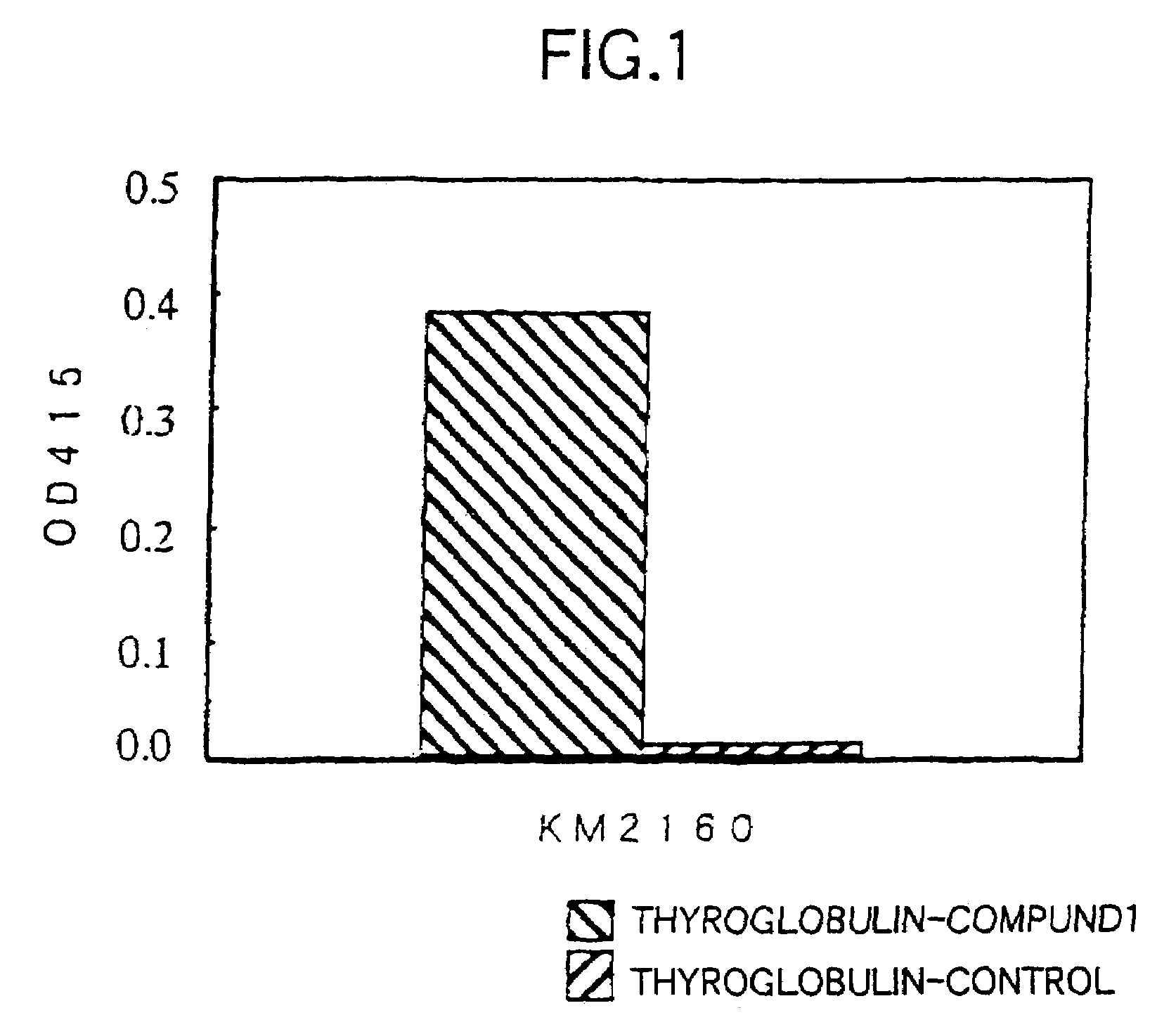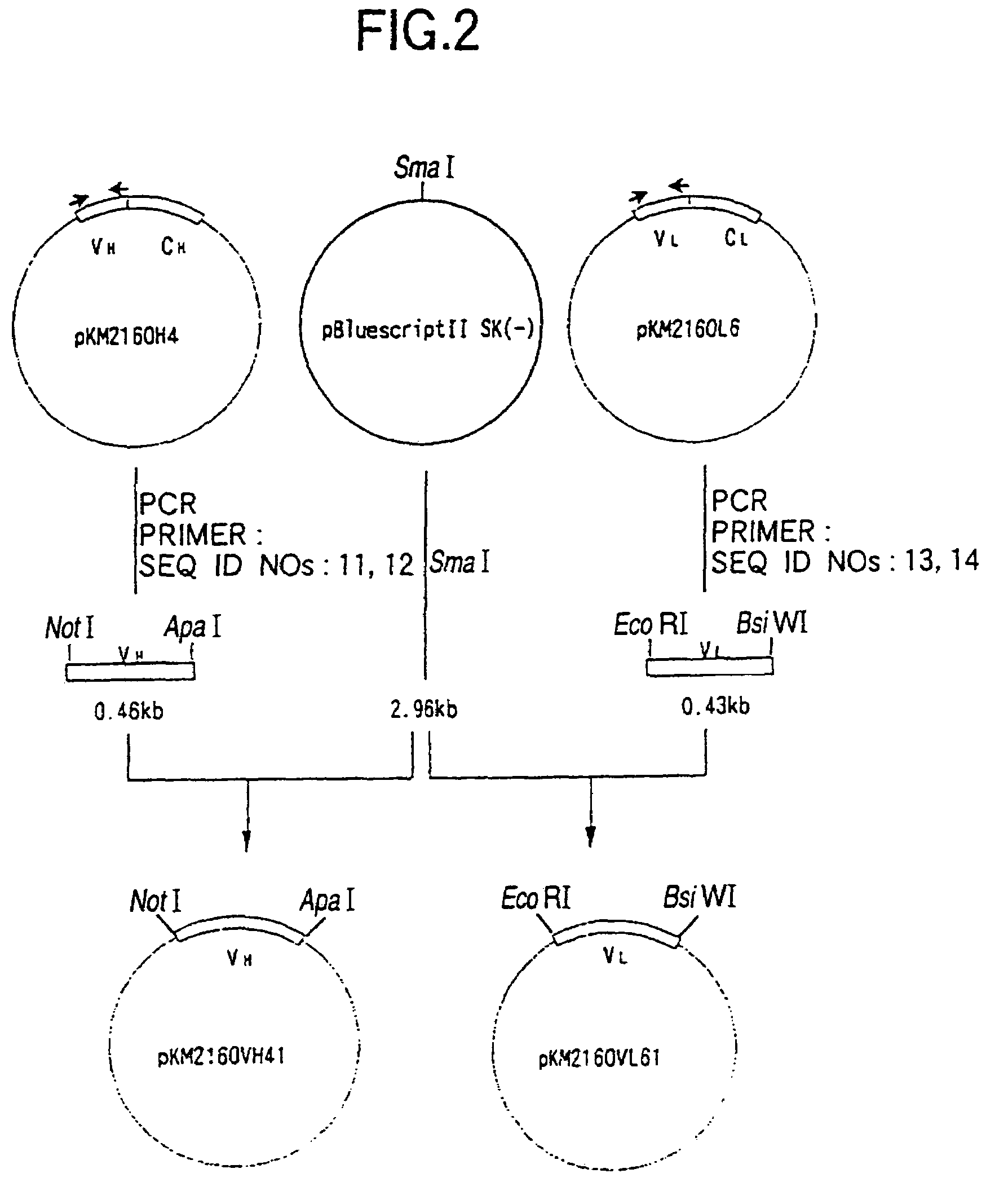Method for treating Th2-mediated disease
a th2-mediated disease and antibody technology, applied in the field of recombinant antibodies and antibody fragments, can solve the problems of drug resistance, inability to avoid side effects of steroids, and withdrawal of accompanying strong immunosuppressive effects, so as to reduce the number of antigen-positive cells, show the utility of antibody in use, and reduce the effect of antigen-positive cells
- Summary
- Abstract
- Description
- Claims
- Application Information
AI Technical Summary
Benefits of technology
Problems solved by technology
Method used
Image
Examples
example 1
[0251]Production of hybridoma cell which produces mouse anti-CCR4 monoclonal antibody:
[0252]Hybridoma cells which produce mouse anti-CCR4 monoclonal antibody KM2160 (Int. Immunol., 11: 81 (1999)) were produced according to the following procedure.
(1) Preparation of Antigen
[0253]The amino acid sequence (SEQ ID NO:17) of human CCR4 (hereinafter referred to as “hCCR4”) protein was analyzed by using Genetyx Mac™, and Compound 1 (SEQ ID NO:1) was selected as a partial sequence considered to be appropriate as the antigen among portions having high hydrophilicity, N-terminal and C-terminal. Also, a portion of the amino acid sequence of a mouse CCR4 (hereinafter referred to as “mCCR4”) (BBRC, 218: 337 (1996)) protein corresponding to Compound 1 was selected as Compound 2 (SEQ ID NO:2). SEQ ID NOs:1 and 2 correspond to positions 2-29 from the N-terminal amino acids of human CCR4 and mouse CCR4, respectively.
[0254]Abbreviations of the amino acids and their protecting groups used in the presen...
example 2
Preparation of anti-CCR4 chimeric antibody:
1. Isolation and analysis of cDNA encoding the V region of anti-CCR4 mouse antibody:
(1) Preparation of mRNA from hybridoma cells which produces anti-CCR4 mouse antibody
[0288]A mRNA was prepared from the hybridoma cell KM2160 described in Example 1. About 48 μg of mRNA was prepared from 8×107 cells of the hybridoma cell KM2160 using a mRNA preparation kit, Fast Track mRNA Isolation Kit™ (manufactured by Invitrogen) according to the manufacture's instructions.
(2) Production of H Chain and L Chain cDNA Library of Anti-CCR4 Mouse Antibody
[0289]cDNA having EcoRI-NotI adapters on both termini was synthesized from 5 μg of the KM2160 mRNA obtained in 1(1) of Example 2 using cDNA Synthesis kit (manufactured by Amersham Pharmacia Biotech) according to the manufacture's instructions. The thus prepared cDNA was dissolved in 20 μl of sterile water and fractionated by agarose gel electrophoresis, and about 1.5 kb cDNA fragments corresponding to the H cha...
example 3
Analysis of function of anti-CCR4 chimeric antibody:
1. Evaluation of Activity of Anti-CCR4 Chimeric Antibody
(1) Reactivity of Anti-CCR4 Chimeric Antibody for Human and Mouse CCR4 (ELISA)
[0309]Reactivity of the purified anti-CCR4 chimeric antibody KM2760 to human CCR4 and mouse CCR4 was measured by ELISA shown in 2(3) of Example 2. The hCCR4 partial peptide (Compound 1) and mCCR4 partial peptide (Compound 2) obtained in Example 1(2) were conjugated with THY and used as the antigen. The preparation was carried out in the same manner as in Example 1(2), except that SMCC (manufactured by Sigma) was used instead of MBS as the crosslinking agent. FIG. 6 shows a result of the examination of reactivity in which the CCR4 peptide conjugate to be adhered was fixed to each well of a ELISA plate to 10 μg / ml and 50 μl / well and the concentration of the anti-CCR4 chimeric antibody KM2760 to be added was changed. As shown in FIG. 6, the anti-CCR4 chimeric antibody KM2760 had almost binding activity ...
PUM
 Login to View More
Login to View More Abstract
Description
Claims
Application Information
 Login to View More
Login to View More - R&D
- Intellectual Property
- Life Sciences
- Materials
- Tech Scout
- Unparalleled Data Quality
- Higher Quality Content
- 60% Fewer Hallucinations
Browse by: Latest US Patents, China's latest patents, Technical Efficacy Thesaurus, Application Domain, Technology Topic, Popular Technical Reports.
© 2025 PatSnap. All rights reserved.Legal|Privacy policy|Modern Slavery Act Transparency Statement|Sitemap|About US| Contact US: help@patsnap.com



